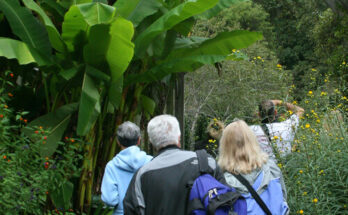There are two easy ways to harm a plant, both because of oversimplification inadvertently. The first is to water on a schedule, and the second is to provide only one type of sunlight.
But what exactly does “one type of sunlight” mean? Simply put, the sun’s rays pass through the atmosphere on their way to your plant.

In the morning, their intensity is diluted because there’s more atmosphere in the way. However, when the sun is at its highest, the rays are hitting with a minimal atmosphere.
And this brings us to the question of Hydrangeas and sunlight.
Just how much do they need, how does your location affect this amount, and how can you tell if your hydrangea is getting the wrong amount?
Let’s take a detailed look at all of these questions and more.
How Much Sun Do Hydrangeas Need?
As a general rule, hydrangeas prefer bright, indirect light throughout most of their USDA hardiness zone range.
But the exact amount depends on the individual species or cultivar.
Duration vs. Intensity
Light is measured in two specific ways when it comes to plants. The duration is how long the plant needs exposure to a specific amount of light (usually direct) to be at its healthiest.
The ideal for climbing, mophead, and oakleaf hydrangeas is 3 to 6 hours of full sun per day. Meanwhile, others prefer around 6 to 8 hours of full sun per day.
But remember, “full sun” doesn’t refer to just any point in the day. Mornings and evenings have a more mild full sun than afternoons.
We’ll get into more detail on this later.
The intensity, meanwhile, measures how directly the light is hitting the plant and is usually described in the following categories:
- Full sun
- Bright, indirect light
- Filtered light (AKA dappled light)
- Light shade
- Partial shade
- Heavy shade
- Full shade
- Low light
In the case of hydrangeas, the preference is for dappled sunlight, but it can tolerate partial shade to full sun, depending on the time of day.
One could say that a plant can generally go two levels in either direction on the lighting scale before suffering, but this isn’t always true.
Where You Are Matters!
Something else that we need to discuss is where you live.
A hydrangea living in an arid region, such as in much of Arizona, will need more shade than the same plant growing in a temperate Vermont garden.
Consider the sun’s intensity (especially ultraviolet rays) and plan accordingly.
Thus, you’ll want to give your hydrangea full morning or evening sun with partial shade in the middle of the day in harsher climates, but in northern regions where the sun never gets too intense, you can give the plant full afternoon exposure.
For much of the US, planting your hydrangea, where it’ll get a little dappling from a nearby tree in the afternoon and indirect light for much of the day overall, is perfect.
But before we move on, we have to stress that different types of hydrangea plants will need slightly different amounts and intensities of light, so what we’re suggesting here is only a baseline.
Please research the exact variety or cultivar you own to get more precise requirements for that plant.
Signs of Inadequate Sunlight
Sometimes you plant a hydrangea in the wrong spot and need to move it, but how do you know when sunlight is the problem?
A lack of sunlight can cause several issues for your hydrangeas.
One of the worst is that low light will make the stems brittle, resulting in a higher risk of damage from strong winds or being bumped by humans or pets.
These same stems may also become scraggly, stretching out to reach better lighting conditions.
This same lack of sunlight can result in slower evaporation, which can invite fungal infections, infestations, and other health issues.
Finally, the biggest symptom is that your hydrangea will fail to bloom.
Flowering takes a lot of energy, much of which comes from photosynthesis. If the leaves aren’t able to absorb enough light, the plant won’t be able to bud.
Signs of Overexposure to Sun
On the flip side of the coin, excess sunlight can pose its own problems.
Even if the light isn’t too harsh, excess light will dry out the soil faster.
This can lead to additional problems, especially if you aren’t practicing proper watering techniques.
The leaves can dry out and curl or become brittle because the water evaporates too fast.
Also, harsh sunlight can result in sunburn, leaving behind dry, yellow spots.
In the event of recent rain, things can get even worse, with the water droplets acting as miniature magnifying glasses.
Finally, you might notice the plant’s leaves drooping after a particularly hot or sunny day.
In such cases, the leaves may also feel less rigid, yet the timing indicates that the plant’s actually dehydrated due to the heat.
When you see this particular combination of signs, it’s important to check the soil and water the plant if needed.
A Final Note On Sun Care
One of the great things about hydrangeas is that they’re easy to transplant.
If your hydrangea is getting the wrong amount of sunlight, consider shifting it to another part of the garden.
Proper watering techniques, such as the soak and dry method (and avoiding overhead watering), are also great ways to help reduce the risk of sun-related problems.
Also, never forget that some types of hydrangea prefer more sun or cooler climates than others.
When in doubt, always look up specific care information for your plants instead of relying upon the general info for a species or genus.
Source link
Originally posted 2023-02-21 15:28:37.





